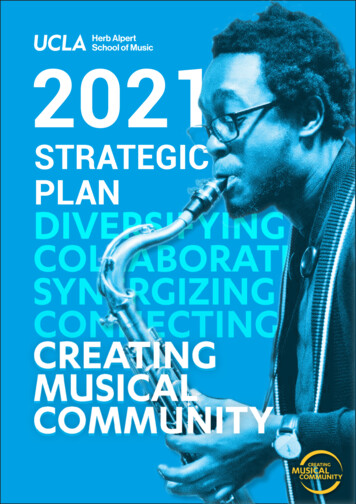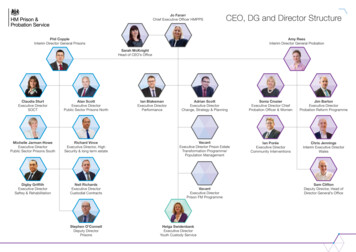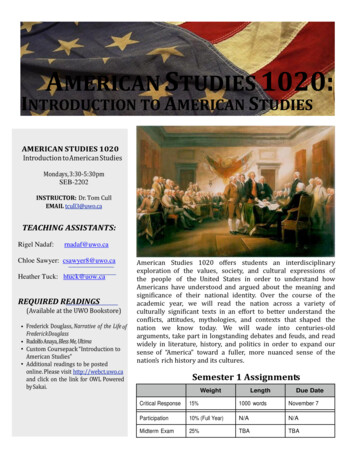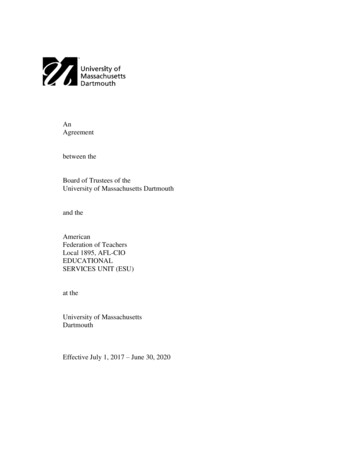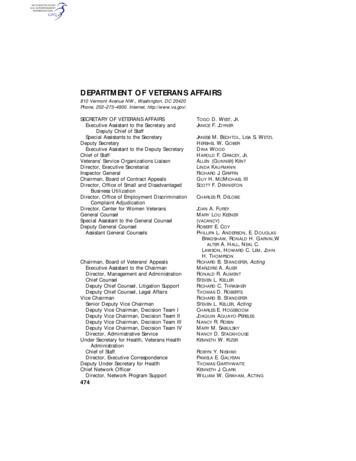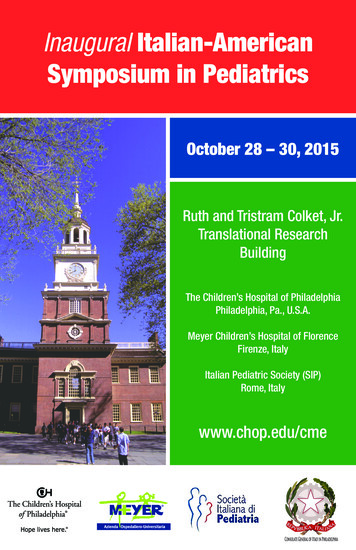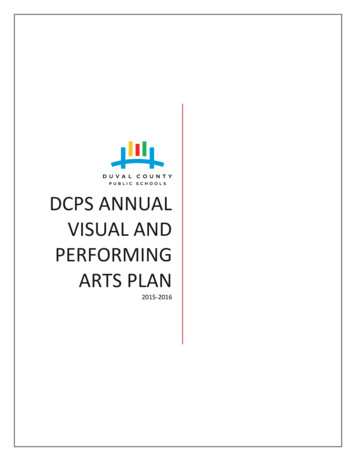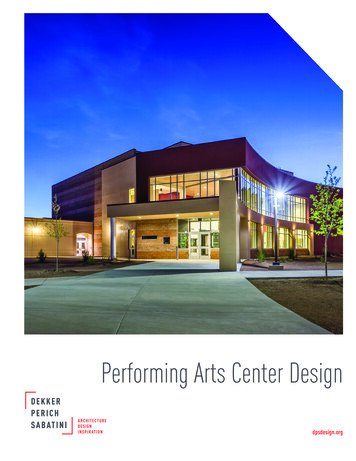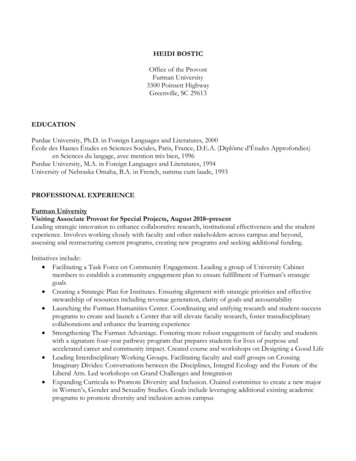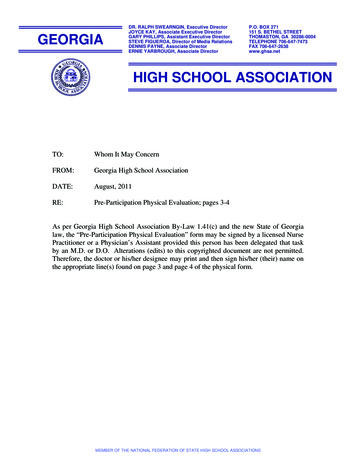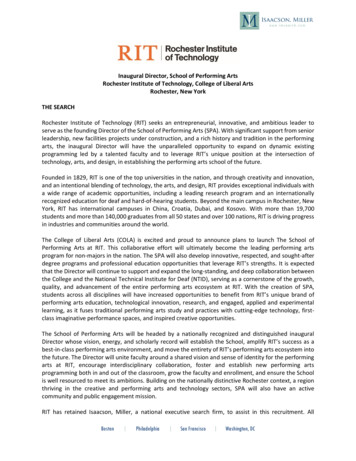
Transcription
Inaugural Director, School of Performing ArtsRochester Institute of Technology, College of Liberal ArtsRochester, New YorkTHE SEARCHRochester Institute of Technology (RIT) seeks an entrepreneurial, innovative, and ambitious leader toserve as the founding Director of the School of Performing Arts (SPA). With significant support from seniorleadership, new facilities projects under construction, and a rich history and tradition in the performingarts, the inaugural Director will have the unparalleled opportunity to expand on dynamic existingprogramming led by a talented faculty and to leverage RIT’s unique position at the intersection oftechnology, arts, and design, in establishing the performing arts school of the future.Founded in 1829, RIT is one of the top universities in the nation, and through creativity and innovation,and an intentional blending of technology, the arts, and design, RIT provides exceptional individuals witha wide range of academic opportunities, including a leading research program and an internationallyrecognized education for deaf and hard-of-hearing students. Beyond the main campus in Rochester, NewYork, RIT has international campuses in China, Croatia, Dubai, and Kosovo. With more than 19,700students and more than 140,000 graduates from all 50 states and over 100 nations, RIT is driving progressin industries and communities around the world.The College of Liberal Arts (COLA) is excited and proud to announce plans to launch The School ofPerforming Arts at RIT. This collaborative effort will ultimately become the leading performing artsprogram for non-majors in the nation. The SPA will also develop innovative, respected, and sought-afterdegree programs and professional education opportunities that leverage RIT’s strengths. It is expectedthat the Director will continue to support and expand the long-standing, and deep collaboration betweenthe College and the National Technical Institute for Deaf (NTID), serving as a cornerstone of the growth,quality, and advancement of the entire performing arts ecosystem at RIT. With the creation of SPA,students across all disciplines will have increased opportunities to benefit from RIT’s unique brand ofperforming arts education, technological innovation, research, and engaged, applied and experimentallearning, as it fuses traditional performing arts study and practices with cutting-edge technology, firstclass imaginative performance spaces, and inspired creative opportunities.The School of Performing Arts will be headed by a nationally recognized and distinguished inauguralDirector whose vision, energy, and scholarly record will establish the School, amplify RIT’s success as abest-in-class performing arts environment, and move the entirety of RIT’s performing arts ecosystem intothe future. The Director will unite faculty around a shared vision and sense of identity for the performingarts at RIT, encourage interdisciplinary collaboration, foster and establish new performing artsprogramming both in and out of the classroom, grow the faculty and enrollment, and ensure the Schoolis well resourced to meet its ambitions. Building on the nationally distinctive Rochester context, a regionthriving in the creative and performing arts and technology sectors, SPA will also have an activecommunity and public engagement mission.RIT has retained Isaacson, Miller, a national executive search firm, to assist in this recruitment. AllBoston Philadelphia San Francisco Washington, DC
Page 2 of 12Director, School of Performing ArtsRochester Institute of Technologyinquiries, nominations, and applications should be submitted to the search firm as indicated at the end ofthis document.ROCHESTER INSTITUTE OF TECHNOLOGYRochester Institute of Technology is a nationally ranked university and home to leading creators,entrepreneurs, innovators, and researchers. The university enrolls more than 16,700 undergraduates andover 3,000 graduate students in more than 200 programs, making it among the largest private universitiesin the U.S. RIT is internationally recognized and ranked for academic leadership in business, computing,engineering, imaging science, liberal arts, sustainability, and fine and applied arts. RIT also offersunparalleled support services for deaf and hard-of-hearing students. The cooperative education programis one of the oldest and largest in the nation. Global partnerships include several international campuses.The university revised its 2025 strategic plan, Greatness Through Difference, in the fall of 2018. The planleverages the university’s unique history with a renewed focus to use the interdisciplinary power oftechnology, the arts, and design to shape the future and the world.Over the past 10 years, RIT has seen advancement in every key institutional metric. Applications haveincreased 70 percent. Enrollment has grown 20 percent to nearly 20,000 students, with both studentcaliber and the diversity of the student population on the rise. Cooperative education, a pillar in the RITeducational philosophy, has thrived, both domestically and internationally, helping demonstrate theuniversity’s exceptional ROI with a 95-percent post-graduation employment rate. Faculty have grown innumber, diversity, and scholarly stature as RIT has increased its research productivity while remainingdeeply student focused. Transforming RIT: The Campaign for Greatness, a 1 billion fundraising campaignwhich was publicly announced in July 2018, is focused on continuing to advance these hallmarks of theuniversity. Today, RIT counts more than 140,000 alumni around the world. Its endowment is currentlyvalued at more than 930 million, and the university benefits from sound financial management.For more information on RIT please see the appendix at the end of the document.COLLEGE OF LIBERAL ARTSThe College of Liberal Arts (COLA) is central to the university’s ability to provide excellent and wellrounded undergraduate and professionally oriented graduate education. Over the past decade, COLA hasgrown in research, development of creative new programs, and the recruitment of faculty who areexcellent scholars and educators, and the college is poised to be a key player in the university’s ambitiousplans for new creative programs, research growth, and increased public engagement while continuing toprovide students an invaluable grounding in the liberal arts.The college is home to two schools (Communication and Performing Arts); 9 departments (CriminalJustice, Economics, English, History, Modern Languages and Cultures, Philosophy, Psychology, PublicPolicy, and Sociology and Anthropology); and several interdisciplinary programs. COLA enrolls nearly 600undergraduate majors across 16 programs and over 70 graduate students in five master’s programs andis responsible for over 20 percent of total credit hours taught and a quarter of the core curriculum classeson campus. The college is comprised of 170 full-time faculty, 130 adjunct faculty, and 49 staff. Home to anumber of interdisciplinary research centers and institutes, sponsored research in the college totaled 2.9million in fiscal year 2020.
Page 3 of 12Director, School of Performing ArtsRochester Institute of TechnologySCHOOL OF PERFORMING ARTSFounding VisionStudent participation in performing arts programs has been found to develop strong bonds outside ofstudents’ normal social circles, increase personal confidence, improve academic performance (includingin STEM subject areas), expand creative and critical thinking skills, advance leadership and team building,and develop an appreciation for unique perspectives. With the creation of the School of Performing Arts,RIT students across all disciplines will have increased opportunities to benefit from RIT’s unique brand ofperforming arts education, technological innovation, research, and engaged, applied, and experimentallearning, as it fuses traditional performing arts study and practices with cutting-edge technology, firstclass imaginative performance spaces, and inspired creative opportunities. Building on the nationallydistinctive Rochester context, a region thriving in the creative and performing arts and technology sectors,the SPA will also have an active community and public engagement mission. The Rochester area ranks 17thin the nation for ‘Arts Vibrancy’ per the National Center for Arts Research.Funding for SPA initiatives will be supported centrally through the allocation of ten new full-time facultylines as well as separate funding lines to support Performing Arts Scholars activities, student tuition fordegree programs, grant support from external sources, professional and executive education, anddevelopment dollars. This exciting new school could offer several major naming opportunities.The SPA is expected to be formally constituted by the end of the academic year 2021-22, with formallaunch activities and accompanying marketing and media campaign to be undertaken at the start of theacademic year 2022-23.Academic ProgrammingInitiated in 2018, ongoing planning for interdisciplinary performing arts collaborations regarding curricula,immersions, and degree programs include discussions across many colleges and units at RIT. The SPA plansto further synergize its relationship with the entire RIT community by actively recruiting faculty associatesfrom colleges across RIT and linking existing and planned degree programs. The SPA plans to add to itsexisting strengths by recruiting faculty members with an active research and creative agenda, outstandingteaching and performance skills, and exceptional talent in multiple aspects of the performing arts. Thefaculty’s commitment to multi-disciplinary inquiry, the integration of technology and digital worlds withthe performing arts, and innovation discovery will be critical to the School’s success.The College of Liberal Arts current Performing Arts Department is rich in academic program offerings andapplied learning of the performing arts, boasting more than a dozen performing arts musical and choralensembles, dance and theatre groups, as well as the opportunity for students to pursue their craft throughindividual lessons. COLA’s Performing Arts Department currently offers three minors in MusicPerformance, Music Technology, and Theater as well as two immersions in Music (history, theory, andpractice of music) and Theater Arts (dramatic literature, theater history, theory, and practice). The Collegehas broad and diverse strengths in areas that add breadth as well as distinctiveness to the entireperforming arts environment, such as narrative storytelling, creative writing, virtual reality, digitalhumanities, computational processing, visual studies, exhibitions, aesthetics, communication, advertisingand marketing, social psychology, cinema and film studies, and voice recognition and natural language
Page 4 of 12Director, School of Performing ArtsRochester Institute of Technologyprocessing. The formation of the SPA provides great opportunity to advance connections with existing RITstrengths in computing, music technology, digital design, gaming, AR/VR/IR, and entertainmentmanagement/business across campus.Many synergistic, long-standing, and deep cross-campus collaborations in performing arts integrate thenationally recognized strengths of the National Technical Institute for the Deaf (NTID). NTID faculty andprograms will be a cornerstone of the growth, quality, and advancement of the entire performing artsecosystem at RIT, with a particular focus on dance and theater. NTID has a 55-year history of performingarts programming for Deaf, hard of hearing, and hearing audiences. This is a nationally unique advantagefor RIT and the SPA. There is significant opportunity to pursue joint faculty lines, programs, degrees, andprograms with between COLA and NTID. NTID’s existing performing arts academic offerings are extensivein dance, mime, visual theatre, theatre technology, and production design (props, costume, lighting,makeup, technical support, etc.). The department offers a certificate program open to all NTID and RITstudents and has initiated a partnership with nationally renowned Garth Fagan Dance. NTID also has anextensive production repertoire across a range of the performing arts.Performing Arts Scholars ProgramRecognizing that the performing arts cultivate skills that are intrinsic to a creative and successful life andcareer, the resoundingly successful Performing Arts Scholars (PAS) program, now in its third year, wasconceived to give students who have a background in the performing arts the opportunity to remainactively engaged in their art, regardless of their degree discipline. RIT seeks these students because theyare not only talented, engaged, and well-rounded individuals, but also goal-oriented, academic highachievers, self-starters, and team players. Strong enthusiasm from incoming students has rocketedenrollment well past the University’s projected benchmarks, growing from 126 scholars in year one to 460scholars in year three, currently totaling 952 scholarship recipients from across all nine RIT colleges. Thepersistence rate of the program has likewise proved remarkably strong, with a 92% retention for the 1920 cohort and 100% retention for the 20-21 cohort. Benefits of the program include a four-year renewablescholarship, a faculty mentor with expertise in their particular performing arts discipline, and numerousenrichment opportunities. The Performing Arts Scholars Program is led by a director who reports directlyto the SPA Director.Extracurricular Performing ArtsIn addition to the myriad COLA and NTID curricular performing arts ensembles, productions, courses, andactivities, there are also upwards of several dozen performance-based student clubs and organizations onthe RIT campus. RIT also has its own record label, Tiger Records. As just a sampling, RIT is home to sevena cappella groups, a Game Symphony Orchestra (approximately 200 members including alumni), a PepBand (100 members), the RIT Student Music Association, the RIT Players theater club, the prizewinningRIT Drumline, seven dance groups of various styles, etc. While these clubs are under the aegis of StudentAffairs/Campus Life, they rely heavily on the support of the COLA and NTID performing arts departmentsin terms of space, equipment, and staff and faculty support. There are opportunities to expandcollaborations with Dining and Housing to integrate Performing Arts within these campus units as well,with conversations about specific housing floors for Performing Arts Scholars recently initiated. It will bevital in the formation of the SPA that a holistic, inclusive, and accessible perspective of all performing artsacross the campus, including these popular student groups, is taken into consideration.
Page 5 of 12Director, School of Performing ArtsRochester Institute of TechnologyFacilitiesAs part of the current RIT campaign and strategic plan, two new complexes are under construction, withcommitted funds, on campus to support the performing arts. These buildings will provide the footprintnecessary to facilitate hands-on practical experience and education for students in both the performativeand behind-the-scenes technical aspects of music, theatre, dance, and other arts disciplines. The facilitieswill not only allow the continued exploration of traditional ideas of performing arts but will embraceemerging digital and interactive performance fields as well.Slated to open in fall 2023, the SHED (Student Hall for Exploration and Development), a 100,000 plussquare foot student-centered makerspace open to the RIT community, will include a glass box theater, amulti-purpose music and theater showcase and rehearsal room, a dance studio, and six basement practicerooms.The first phase of a two-theater performing arts complex, Music Performance Theater, will include a 750seat performance hall designed specifically for musical theater, dance, and amplified music concerts. Itwill also house a historic and refurbished theater organ donated to RIT. Additional spaces included in thefirst phase include a scene shop, a costume shop, and two rehearsal rooms, as well as offices for the boxoffice, concessions, and production staff. A second phase of the Music Theater Performance complex isyet uncommitted but will include a 1,500-seat orchestra hall for larger engagements including acousticperformances by traditional RIT music ensembles as well as professional community groups such as theRochester Philharmonic Orchestra. The facility is also intended for use by other large-scale campus eventsand could be rented for public events such as the Rochester Jazz Festival.NTID boasts excellent existing performing arts facilities in Lyndon B. Johnson Hall including the Robert F.Panara Theater (400 seats), the 1510 Lab Theater, and the Dance Lab, in addition to a costume shop, sceneshop, green room, dressing rooms, and administrative office space. An upcoming renovation of the firstfloor of LBJ Hall is planned to update dance and rehearsal spaces for both internal and external uses,create nonbinary locker rooms, upgrade all lighting to LEDs in Panara Theater, consolidate office andsupport space, and ensure all proper code requirements are met.COLA hosts classrooms, practice rooms, an ensemble library, a music production master workstation, amusic technology lab, and temporary rental trailer spaces that houses RIT Tiger Records, commercialmusic, and rock band rehearsals. Additional facilities are in development to support the growth of SPA.THE ROLE OF THE DIRECTORReporting to the Dean of the College of Liberal Arts, the Director will be responsible for enhancing thevision and strategic implementation of the entire performing arts ecosystem at RIT. Specific duties includeoversight of existing curricula and academic programs; the development of new programs; the activitiesof the Performing Arts Scholars Program; supporting existing faculty’s professional development andhiring new faculty; the fostering of research and creative inquiry; securing external funding throughgrants, philanthropy, and gifts; advancing marketing and communication; supporting campus productionsand presenting programming; and developing partnerships with all performing arts related initiatives atRIT and beyond.
Page 6 of 12Director, School of Performing ArtsRochester Institute of TechnologyThe Director will work closely with Academic Program Director(s), the Director of the Performing ArtsScholars Program, the Operations Director, and the Chair of the NTID Performing Arts Department. Thereis dedicated administrative support for the SPA. The COLA Office of Student Services provides studentrecruitment, advising, and career education support.An administrative council comprised of one representative from each academic unit offering courses forthe SPA will meet regularly to advise the Director on effective and inclusive management of the school.In addition to the internal governance structures and processes briefly mentioned above, the SPA will beadvised by an external advisory board made up of community partners, nationally recognized performingarts scholars, and benefactors. The advisory board will liaison with the performing arts community inRochester and beyond and will help the school make strategic decisions and develop programmaticinitiatives. The inaugural external advisory board will be set up in 2022-23 under the leadership of thefounding director.OPPORTUNITIES & CHALLENGESThe inaugural Director of the School of Performing Arts at RIT will be charged with addressing thefollowing opportunities and challenges:Provide vision and strategic direction in launching the School of Performing Arts, establishing the Schoolas an innovative leader in creative practiceThe inaugural Director will join the School of the Performing Arts at the exciting moment of its foundingand amidst an institution that is already rich in academic program offerings and applied learning of theperforming arts and sees them as critical to its future growth, distinction, and success. The Director willbe expected to collaborate with faculty, staff, students, and external partners to develop a forwardthinking vision and set strategic goals that will establish and enhance the School’s stature and reputation.The Director will be expected to capitalize on the SPA’s broad disciplinary reach while creating a cohesivesense of shared identity for the School and its units; identify opportunities for unique partnerships andcollaboration within COLA, NTID, RIT, and the wider Rochester community; and ensure that programs arepedagogically and artistically strong, intellectually challenging, and grounded in clear plans for realisticfiscal and infrastructure support. The Director will offer compelling and inspirational leadership,energetically promoting the role and value of the performing arts in a collaborative and innovativeacademic environment.Recruit, retain, develop, and support a diverse facultyThe Director will be charged with providing the staffing and infrastructure to support teaching, learning,and research across the SPA. Current COLA and NTID faculty and staff are deeply invested in the successof the performing arts programs being offered but are stretched thin. Working with the Dean and COLAleadership, the Director will need to develop resources, both human and fiscal, to meet the ambitiousaspirations for the SPA. RIT has committed to robust faculty and staff hiring over the coming five-yearperiod; up to a total of ten full-time incremental lines are expected to be added by 2027. It is a priority forthe institution that some of these lines are joint with other units to integrate the performing arts acrossthe entire institution. In addition, any SPA hiring will prioritize RIT’s ambitious goals for enhancing
Page 7 of 12Director, School of Performing ArtsRochester Institute of Technologydiversity, equity, and inclusion. SPA hiring will leverage multiple faculty categories, from tenured andtenure-track faculty to lecturers, visiting positions, adjuncts, professors of the practice, and artists-inresidence across the full breadth of performing arts disciplines.Connect the School of Performing Arts programs and activities with student successWith interests as diverse as their backgrounds, all RIT students should be prepared to lead fulfilling livesin an increasingly changing world, and the institution recognizes that the performing arts cultivate skillsthat are intrinsic to a creative and successful life and career. Inherent in SPA’s mission to become theleading performing arts program for non-majors in the nation, the Director will be expected to support avibrant student experience across all majors and increase opportunities for students to benefit from RIT’sunique brand of performing arts education. The Performing Arts Scholars program has seen strongenthusiasm from incoming students with robust enrollments and impressive student outcomes. TheDirector will ensure that both curricular and cocurricular programs offer multiple and varied opportunitiesto engage in the performing arts, are sound pedagogically, and are properly resourced and staffed. TheDirector will work to ensure that there are explicit connections between students’ classroom and cocurricular experiences with exposure to the world they will engage in upon graduation. Future goals areto expand opportunities for nonmajors to include internships, national and international conferences, andstudy abroad programs.Serve as a visible champion for the Performing Arts internally and externallyThe successful Director, as the external face of the School, will promote and champion the work of theSPA on the local, national, and international stage. Working in conjunction with other academic units andUniversity leadership, the next leader will identify new opportunities for cross-disciplinary, inter-schoolpartnerships and initiatives, and develop creative strategies for further student and faculty integrationwithin the greater RIT community. Similarly, it will be important for the Director to be well networkedacross the performing arts community and work to build bridges with the Rochester arts community,developing beneficial partnerships and celebrating the success of the School with external audiences. Acommitment to building partnerships from the local to the international levels will be key to extendingthe impact of the SPA.Develop the School’s fundraising base and build key partnerships toward resource growthWhile RIT has committed robust resources and support to launch the School, the inaugural Director willbe expected to work closely with University Advancement, COLA leadership, and faculty to developcompelling and effective opportunities to attract philanthropic support and ensure the School is resourcedto meet its ambitions and full potential. Looking to the future, the next Director will need to expand onthis solid foundation, building philanthropic bridges to alumni, donors, arts leaders, and policy makers totell the story of the performing arts at RIT, its successes and aspirations. The Director will also be expectedto develop strategic and fruitful relationships with industry leaders locally and nationally.QUALIFICATIONS AND CHARACTERISTICSRIT and COLA seek candidates with strategic vision, strong management skills, a commitment to accessand inclusivity, and a successful record of administration within a complex environment of
Page 8 of 12Director, School of Performing ArtsRochester Institute of Technologytransformation. The successful candidate will be an experienced leader with a track record ofachievement and innovation in a diverse higher education institution. They will demonstrate acommitment to excellence, equity, and educational opportunity, and to encouraging and inspiringdiverse faculty and staff as individuals in an academic and creative community. The inaugural Directorwill bring many of the following personal qualities and professional characteristics: A deep appreciation for the fields represented within the School of Performing Arts and anability to articulate the vision, mission, achievements, and ambitions of the School to a diverseaudience;Ability and eagerness to advance the School towards aspirations and goals;An energetic, entrepreneurial, diplomatic, and consultative leadership style that inspires faculty,students, staff, and community members alike;Nuanced understanding of issues related to access, diversity, equity, and inclusion in educationand the arts, including an appreciation of Deaf and hard-of-hearing culture; and demonstratedexperience shaping initiatives to increase and support inclusive excellence among students,faculty, and staff;The ability to work cooperatively and effectively with administrators, faculty, students, staff, andother external constituencies;Comfort with ambiguity and working within matrixed relationships and enthusiasm for visioningand building from near scratch;An informed grasp of key issues affecting faculty recruitment, retention, promotion, andscholarly productivity;Demonstrated commitment to shared governance and a track record of effective personnel,fiscal, and physical resources management;Successful experience or demonstrated potential in fundraising and development activities;Effective communication and interpersonal skills to represent and advocate for the Schoolinternally and externally;The capacity to identify and think strategically about opportunities for creative partnershipsacross departments and disciplines; and a talent for bringing others on board and buildingmomentum toward a common goal; andAn advanced or terminal degree in a performing arts related discipline is strongly preferred aswell as a scholarly and/or creative record commensurate with appointment as a full professor atRIT.TO APPLYRIT has engaged Isaacson, Miller, a national executive search firm, to assist with this search. Inquiries,nominations, and applications should be directed electronically and in confidence to the firm as directedbelow.Ben Tobin, PartnerElizabeth Dorr, Managing AssociateStephen Kalogeras, AssociateIsaacson, 6
Page 9 of 12Director, School of Performing ArtsRochester Institute of TechnologyRIT does not discriminate. RIT promotes and values diversity, pluralism, and inclusion in the workplace.RIT provides equal opportunity to all qualified individuals and does not discriminate on the basis of race,color, creed, age, marital status, sex, gender, religion, sexual orientations, gender identity, genderexpression, national origin, veteran status, or disability in its hiring, admissions, educational programs,and activities. For more information or inquiries, please visit RIT/TitleIX or the U.S. Department ofEducation at ED.Gov.
Page 10 of 12Director, School of Performing ArtsRochester Institute of TechnologyAPPENDIXROCHESTER INSITUTE OF TECHNOLOGYHistoryFrom its beginnings, RIT has been deeply connected to the educational and practical training needs ofcitizenry and industry. The university’s roots go back to 1829 when the city’s founder established theRochester Athenaeum, a literary society that offered public lectures and debates and attracted suchluminaries as Ralph Waldo Emerson and Oliver Wendell Holmes. In 1891, the Athenaeum merged withthe Mechanics Institute, which had been created and funded by local business and community leaders toprovide technical training to meet local industry’s growing demand for skilled workers. The mergedinstitution—the Rochester Athenaeum and Mechanics Institute—combined cultural education andpractical technical training. In 1912, cooperative education was added to the programmatic mix and thecore foundation was in place for Rochester Institute of Technology, as it has been named since 1944.In 1968, RIT left downtown Rochester for a 1,300-acre new campus
Rochester Institute of Technology SCHOOL OF PERFORMING ARTS Founding Vision . and marketing, social psychology, cinema and film studies, and voice recognition and natural language . Page 4 of 12 Director, School of Performing Arts Rochester Institute of Technology processing. The formation of the SPA provides great opportunity to advance .
